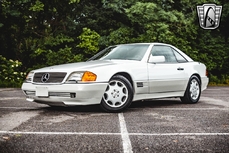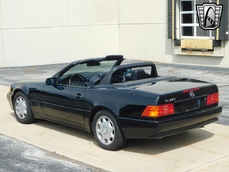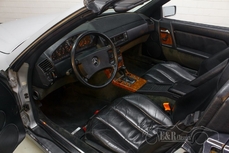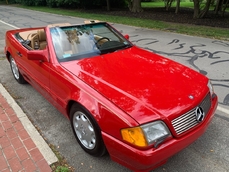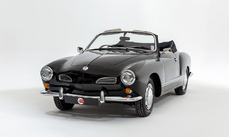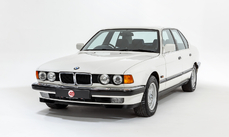Mercedes-Benz 300SL r129 300SL-24 1991
General description :
Model History
Designed and built as a grand tourer the SL was first introduced in 1954. The designation SL derives from the German "Sport Lightweight" and was first applied to the 300SL Gullwing. The SL model range is still in production today and has spanned five generations of models from 1954 to the present day.
The R129, as featured here, is the fourth generation of SL and was built from 1989-2002. Featuring a shorter wheelbase and updated rear suspension over its predecessor, the R107, the R129 was quick to introduce model updates and featured a large amount of styling, mechanical, and technological updates over its 12 year life span.
The R129 shot to the public's attention in 1991 when Diana, Princess of Wales sold her Jaguar to purchase a 500SL. This sparked a media storm as this was the first time a member of the royal family had chosen a foreign car. The media questioned whether British royalty should be driving foreign cars and eventually due to pressure she was forced to return the car to Mercedes-Benz in 1992. The car now features in the Mercedes-Benz Museum.
Equipment
Brilliant Silver Metallic paintwork, Anthracite Leather upholstery, Folding rear seats, Electric-folding soft-top in black, Removable aluminium hardtop in Brilliant Silver Metallic, Eight-hole alloy wheels, Four-speed automatic transmission, Electrically adjustable front seats, Electrically adjustable steering wheel, Mercedes ‘Masterpiece’ leather gear knob, Air conditioning, Kenwood CD player with USB and Bluetooth connectivity, ABS, PAS, Heat insulating glass, Mercedes carpet mats, Central locking, Alloy spare wheel, Wind deflector, Mercedes toolkit, Mercedes first aid kit.
Exterior
This early R129 looks great in bright metallic silver. Although not entirely flawless the body is presentable throughout with only a few imperfections to report. The car could easily be lifted to an excellent standard with some cosmetic paintwork primarily to the boot lid area, or it could simply be driven and enjoyed as-is. Having been replaced in recent years the electric hood presents immaculately and operates smoothly at the touch of a button. The removable hardtop, also in fine order, is the perfect accompaniment for those chillier winter months.
VIEWINGS WELCOME BY APPOINTMENT ONLY /// ADDITIONAL PHOTOS AND VIDEOS AVAILABLE UPON REQUEST
Interior
The black leather is in overall very good condition with only a small amount of expected wear to the driver’s bolster evidencing the car’s age. Other commonly worn or damaged items such as the spectacle box lid, centre console storage covers, and adjustable armrest all look great and present without fault. The walnut veneer on the passenger door has started to lift and there are a few lights marks on the centre console wood trim also. In the boot area you’ll find the original Mercedes tool roll, first aid kit, wind deflector, and matching alloy spare wheel. Please note, a Kenwood CD player with USB and Bluetooth connectivity is currently fitted.
ENGINE & TRANSMISSION
The 24v 3-litre straight-six starts without fuss and idles up to temperature smoothly. The four-speed automatic gearbox operates with ease and handles the engine’s power perfectly. Services have been carried out at the following mileages: 763 – 6,125 – 11,891 – 18,217 – 24,202 – 28,472 – 36,981 – 41,811 – 47,821 – 51,503 – 59,708 – and most recently at 61,200 miles in September 2022. The MOT is valid until November 2023.
WHEELS, TYRES & BRAKES
The Mercedes sits on eight-hole alloys, all in nice original condition with only a few age-related marks visible on close inspection. They are shod in high quality Pirelli tyres with plenty of tread all round; the rears were replaced at 58k miles. The brakes have also recently been checked and remain in fine operational condition.
History File
This 24v SL was first registered in September 1991. Supplied new in Singapore the car boasts a complete supplying-dealer service history up until 41k miles. Since arriving in the UK in 1998 it has been driven sparingly in the hands of only four additional keepers, the odometer now reading just 62,080 miles.
The car has recently been serviced and inspected for the new keeper’s peace of mind. In 2020 the electric roof, central locking, and vacuum system were overhauled by marque specialists R129 Co at a cost of over £2,000. Other notable recent works include a replacement heater motor assembly, renewal of both front lower ball joint gators, an auxiliary belt change, and an air con recharge.
http://www.4starclassics.com/for-sale/mercedes-r129-300sl-24-for-sale/
1991 Mercedes-Benz 300SL r129 300SL-24 is listed sold on ClassicDigest in Kingsley by 4 Star Classics for £8995.
Car Facts
Car type : Car Make : Mercedes-Benz Model : 300SL r129 Model Version : 300SL-24 Engine size : 3.0 Model Year : 1991 Sub type : Coupé Location : Hampshire
Sold
Seller Information
Sold
People who viewed this Mercedes-Benz 300SL r129 also viewed similar Mercedes-Benz listed at ClassicDigest
Other cars listed for sale by this dealer
About Mercedes-Benz
In the annals of automotive history, the journey of Mercedes-Benz is a tale that unfolds with the ingenuity of its founding pioneers. In the year 1886, Karl Benz crafted the Benz Patent Motorwagen, a creation that would go down in history as the world's inaugural automobile. Unbeknownst to him, this moment marked the genesis of what would evolve into the most illustrious premium car manufacturer globally. The financial underpinning of this pioneering venture, interestingly, was provided by Karl Benz's wife, Bertha Benz, demonstrating a remarkable partnership that would set the tone for Mercedes-Benz's legacy.A parallel narrative emerged not far away, as Daimler-Motoren-Gesellschaft, founded by Gottlieb Daimler and Wilhelm Maybach, entered the scene. In 1901, they unveiled their automobile under the now-famous moniker "Mercedes," meaning "godsend" in Spanish. This name was bestowed upon the car at the behest of Emil Jellinek's daughter, the distributor for Daimler-Motoren-Gesellschaft. The wheels of innovation were set in motion.
Fast forward to 1926, a pivotal year that witnessed the merger of Daimler with Benz & Cie., culminating in the birth of Daimler-Benz. The amalgamation saw the adoption of "Mercedes-Benz" as the distinguished trademark for their automobiles, fusing the legacies of two visionary entities into one.
Contrary to perceptions of conservatism, the trajectory of Daimler-Benz unfolds as a chronicle of industry firsts. From the introduction of the honeycomb radiator to the float carburetor, and the pioneering implementation of four-wheel brakes in 1924, Daimler-Benz consistently pushed the boundaries of automotive innovation. The diesel-powered Mercedes-Benz 260 D in 1936 marked the inception of diesel engines in passenger cars. The iconic Mercedes-Benz 300SL Gullwing made history as the first car with direct fuel injection, albeit the Gutbrod's tiny 2-stroke engine can claim precedence.
Safety innovations became a hallmark, with Béla Barényi's patented safety cell design in the "Ponton"-models in 1951, featuring front and rear crumple zones. The W116 450SEL 6.9 saw the introduction of the Anti-Lock Brake system (ABS), another pioneering safety feature. From the first production airbags and beyond, the legacy of "firsts" continued to be etched into the fabric of Daimler-Benz.
Over its centennial journey, Mercedes-Benz has not merely produced cars but has sculpted automotive icons. The SSKL, 710 SSK Trossi Roadster, 770K Grosser, 540K Spezial Roadster, 300SL Gullwing, w100 600 Pullman, w111 280SE 3.5 Flachkühler, w113 230SL Pagoda, w109 300 SEL 6.3, and w201 2.3-16 Cosworth stand testament to the brand's commitment to engineering excellence.
The roaring Silver Arrows, or "Silberpfeile," including the W 25, W 125, W154, W165, and W196, created a legacy of dominance on the racetrack. These machines were not merely cars; they were expressions of precision, speed, and an indomitable spirit that left their competitors in the dust.
As Mercedes-Benz marches into the future, it does so not just as an automaker but as a custodian of a legacy, a torchbearer of innovation, and a beacon of automotive excellence. The road ahead is sure to witness the continued fusion of cutting-edge technology, timeless design, and an unwavering commitment to setting new standards in the world of automobiles.
One luminary figure who left an indelible mark was Béla Barényi, often heralded as the "father of passive safety" for his pioneering work in safety engineering. His patented safety cell design, featuring front and rear crumple zones, became a hallmark of Mercedes-Benz's commitment to occupant safety, setting new standards that reverberated throughout the automotive world.
Moving through the chronicles, the collaborative genius of Wilhelm Maybach, alongside Gottlieb Daimler, laid the foundation for Daimler-Motoren-Gesellschaft. Their innovations not only birthed the first Mercedes but established a culture of relentless pursuit of technological excellence that remains integral to Mercedes-Benz's DNA.
In the post-merger era of 1926, Ferdinand Porsche emerged as a prominent figure within Mercedes-Benz. His work on the Mercedes-Benz S-Type, a supercharged race car, garnered acclaim and set the stage for a legacy that extended far beyond the marque. Porsche's impact would later extend to his eponymous company, but his influence at Mercedes-Benz during those formative years was pivotal.
As the 20th century progressed, the legendary Rudolf Uhlenhaut emerged as a key figure. Uhlenhaut, an accomplished engineer and the driving force behind the iconic Silver Arrows, played a crucial role in Mercedes-Benz's dominance in motorsports. His engineering prowess and attention to detail were instrumental in creating some of the most formidable racing cars of the era.
In the latter half of the century, figures like Bruno Sacco, the head of design at Mercedes-Benz from 1975 to 1999, left an indelible imprint on the brand's aesthetic identity. Sacco's design philosophy, characterized by clean lines and timeless elegance, shaped iconic models like the W126 S-Class and the W201 190E, solidifying Mercedes-Benz's reputation for luxury and sophistication.
The narrative would be incomplete without acknowledging the contributions of engineers like Hans Scherenberg, whose leadership in the 1970s ushered in a new era of technological innovation at Mercedes-Benz. Scherenberg's tenure saw the development of groundbreaking technologies, including the Anti-Lock Brake system (ABS) and the introduction of airbags in production cars.
















